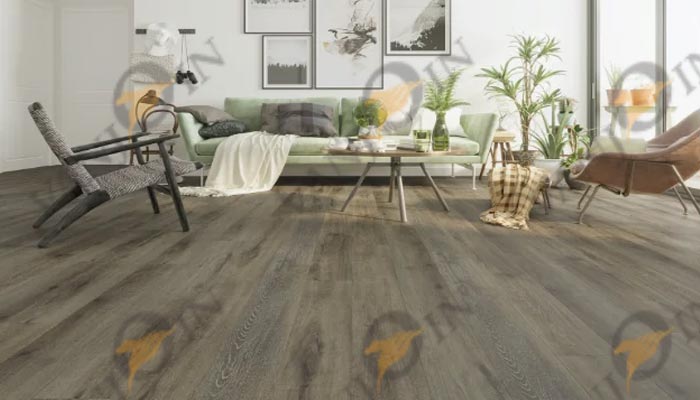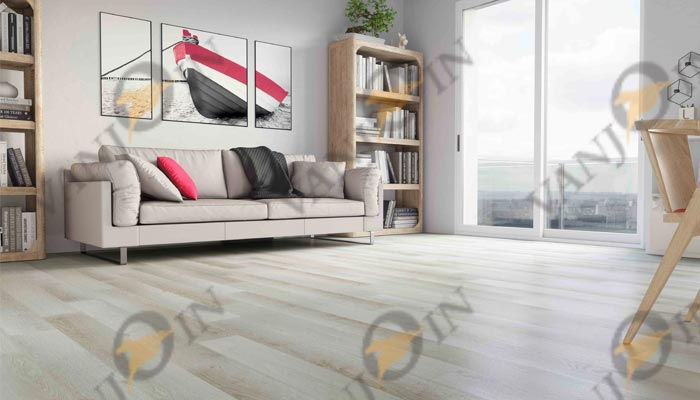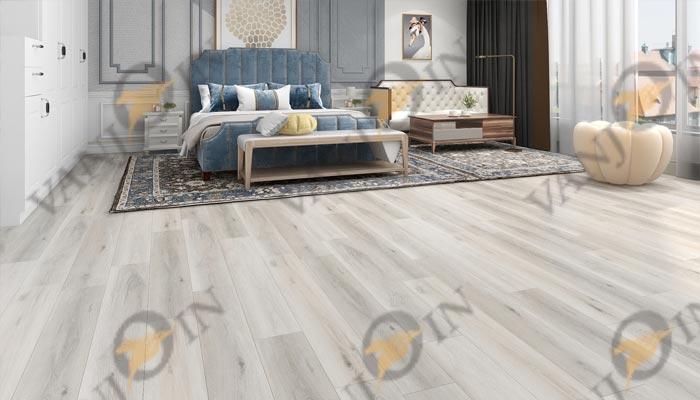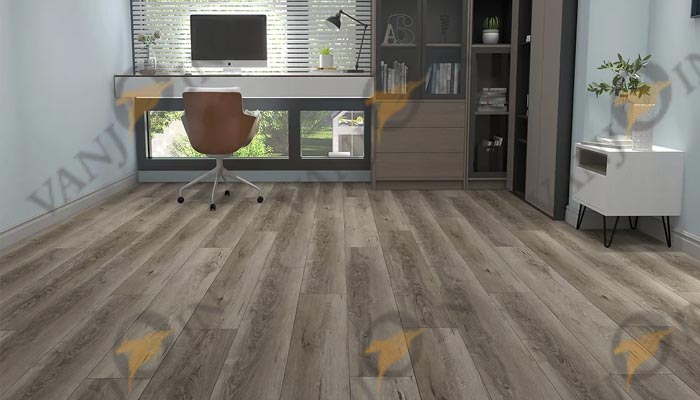Welcome to VANJOIN. Your satisfaction is our biggest pursuit.
Since you may be installing SPC flooring for the first time, this detail guide on what to expect from start to finish of flooring installation will walk you through the whole process.
PREPARATION for SPC Flooring Installation
Preparing your floor before installation is one of the critical steps that you should never miss.
In fact, this very step affects a lot in ensuring a long-lasting and professional finish. So let’s get started with some of the important parts to watch out while getting ready.

1. Sub Floor Condition
Make sure to clean your sub floor and keep it dry completely. Damp surface leads to rising bulges or hydrostatic pressure.
Check for any uneven surface or cracks. You may want to fill up cracks with cement-based patches.
Depending on the type of your existing flooring, do make sure no nails are sticking out above the surface if you are planning to install SPC flooring over your existing floor.
You may try nailing down any loose part to keep a firm surface.
Extra time and cost may be charged by your installer on any minor repair of your existing floor as a preparation for SPC flooring installation.
2. Remove obstacles
Move and store loose furniture and appliances aside.
Clear out flooring accessories like skirting, trim or any fitting that may interfere with installation.
Removing these accessories before you start will make your installation easier and ensure a professional finish.
3. Surrounding Temperature and Humidity
Make sure your room temperature does not fluctuate much (not more than 5°C) during critical period which is 24 hours prior to installation and minimum of 48 hours after installation.
4. Acclimatize Your New Fooring
It is important to let your new flooring adapt to the surrounding condition where you plan to install, at least 24 hours before installation.
Avoid too low (below 2°C) or too warm (above 40°C) storage temperature
Always store your SPC plank flat and not upright.
5. Get Ready With Necessary Tools
Don’t wait until the very last minute, the right tools should come in handy during the installation.
Trust me, there is nothing worse than having to pause in the middle of installation and go off looking for any tools that you’d missed out.
Here’s a list of tools commonly used for SPC flooring installation:
SPC cutting knife / Bolster chisel / Good pair of scissors or Stanley knife / Measuring tape / Pencil / A straight edge / SPC adhesive / Lining paper / Homemade scribing gauge
6. Check With Your SPC Flooring Supplier
If you are planning to diy your SPC flooring, always remember to consult with your supplier if you have any doubts, especially on details like:
Types of adhesive suitable for your flooring
Proper way to handle and store new flooring during installation (damage caused due to improper handling and storing normally does not get covered by warranty)
Review your warranty and confirm you have selected the proper flooring for your intended use.
Types of underlayment to be used
Is your existing floor suitable for installation or must it be removed?
Certain type of flooring that is soft and loose lay like needle felt, carpet, cushion SPC, parquet, and floating laminate are not suitable to have SPC flooring installed on top of it.
7. Mark Your Layout
Plan your layout ahead with precise measurement and careful marking.
Adjust your layout for a balanced look if you are installing SPC plank flooring.
Be sure you are not skipping this step as a rough layout before installation is important to ensure a desired visual appearance.
8. Prepare A Safe Work Environment
If you are planning to install SPC flooring yourself, remember to protect your knees with knee pads as you will be kneeling quite frequently during the process of installation.

SPC Plank Flooring INSTALLATION
Generally, you will find a few installation methods that are applicable to the same type of SPC flooring, depending on the type of SPC flooring you purchased.
Not sure which type of SPC flooring you are having? Check out our guide on type of flooring for a better understanding.
(i) Click-lock SPC Plank Flooring
Click-lock SPC installation is the easiest for first timers who wish to go for diy. This method is sometimes known as floating method.
To apply click-lock or floating method, your SPC plank must come with the long and short side design. So both planks can be click together and form a firm grip. You may also need to measure and cut off any extra length to fit in your area. It is advisable for you to start off your first plank from one corner of the room. Check out the step-by-step floating/ click-lock SPC flooring installation here.
Certain brand of SPC flooring makes diy installing much easier by having planks designed to allow fitting horizontally. This is very helpful when it comes installing in narrow and difficult areas.
(ii) Glue Down SPC Plank Flooring
Moisture content of flooring is important when installing SPC flooring using glue down method. Depending on the type of adhesive you are using, you may want to test for concrete moisture or use moisture barrier.
The main reason here is to keep moisture content under control to prevent possible installation failure or damage of flooring panels that could void your warranty. To be on the safe side, you may want to check with your flooring supplier on the suitable subfloor moisture content before installation.
Besides subfloor moisture content, you should watch out for the type of adhesive use for installation. Make sure you are applying the correct SPC adhesive.
Here’s what you should AVOID:Do not mix adhesive products! Always stick to the adhesive and moisture barriers from the same manufacturer’s product line.
Similar to click-lock SPC plank installation, you should begin your glue down installation from one corner and spread to another end. If possible, try to avoid using outer force with the intention of quick bonding.
Some installers may use clamps or straps to force planks tighter together but this may cause over-strapping. Such condition will adversely affect the floor structure and lead to many flooring issues, for example seam peaking, twisted planks, poor glue-bonding and misalignment.
When applying layers of adhesive during installation, getting the right size of trowel is another important part to maximize the glue-to-board transfer.
If you do not have these information yet, do consider refer to your adhesive manufacturer for trowel size, use of moisture barriers and adhesive set time which changes according to temperature.
For the best results, you can always check with both flooring supplier and adhesive manufacturer if you have any doubts whilst SPC flooring installation. Also, check out our step-by-step glue down SPC flooring installation guide here for further reference.

SPC Sheet Flooring INSTALLATION
If you have purchased SPC flooring in sheet form, here’s what you should expect during your SPC sheet installation.
(i) Permanent Full Spread SPC Sheet Flooring
Permanent bond SPC sheet installation is a must for new construction and for places with heavy traffic. This permanent full sheet adhere method is commonly used by applying permanent pressure sensitive adhesive before spreading out your SPC sheet.
You should avoid placing the sheet when the adhesive is still wet. Instead, let the layer of adhesive dries a little as only a slight portion of adhesive should be transferred underneath the sheet when placing the sheet over the layer of adhesive.
Once placed the sheet on top of the adhesive, you may try to position the sheet without lifting it to avoid forming of wrinkles or air bubbles.
Be extra careful and gentle when cutting large pieces of sheets according to the size of your room to prevent tears. For a professional finish, try not to fold or crease your SPC sheets.
So which part of the room should you start your sheet SPC installation?
Many might assume that it should also begin from one corner of the room, just like click-lock and glue down installation. This is a mistake done by many others without realizing it in the beginning.
(ii) Releasable SPC Sheet Flooring
Releasable SPC sheet installation is one of the most common methods used for sheet SPC installation. But what’s the difference between permanent and releasable SPC sheet installation?
Other than its functionality, the difference during installation is the type of adhesive use and the way to apply it.
Here’s the tricky part.
You do not want to place the sheet on top when the adhesive is still wet as this will cause bubbling but at the same time you should not wait too long until the adhesive is completely dry.
The key is to make sure the layer of adhesive is dry to tack when placing SPC sheet on top. No adhesive is to be transferred underneath the sheet.
Similarly, you should always start installing from the center of the room like permanent full spread SPC sheet installation. Check out the step-by-step guide.
The best part of releasable SPC sheet installation is that it’s suitable to be installed on various sub floors due to the thin layer of adhesive. This thin layer of adhesive is not permanent and allows your SPC sheet to be removable.
(iii) Loose-lay SPC Sheet Flooring
Loose-lay sheet SPC installation is comparatively easy method for diy lover. As mentioned in it’s name, you can simply complete the installation using double sided acrylic tape. And due to this non-adherent method, any mistake made or subfloor problem during installation can be correct by rolling it back.
Not just that, loose-lay sheet SPC installation is suitable to be placed on surface materials that are not applicable for installation that is fully adhered, such as lightweight concrete, chipboard, particleboard, flakeboard, etc.) This method is also hassle free when you remove the sheet at the end of it’s life cycle.
In terms of functionality, loose laid SPC sheet is not able to provide the same sustainability like permanent full spread SPC sheet.
So, if you are planning to install SPC sheet using this method, do consider to install in the area with less traffic. By saying that, it’s obvious that you should not place any fixture or build-in furniture on top of the loose laid SPC sheet for better maintenance.
Here’re some other things to consider before you decide on installing SPC sheet using loose-lay method. Never go for loose-lay SPC sheet installation if:
Your area is larger than two full drops of material
SPC sheet is not rolled face-out
The length of area you wish to install is greater than 30 inches.
The structure of your room is exceptionally “cut up” and complex
Your roll of SPC sheet is distorted
The felt becomes kinked, cracked, or severely folded during installation

SPC Flooring FINISHING
Once finish with the installation, maintain the surrounding moisture content and temperature for 48 hours. This will help stabilize the newly installed flooring and improve durability. If you hired professional installer, you will need to do a proper final inspection to make sure every corner are firmly installed.
If you have extra planks or tiles left after installation, you may save them up and use it for any repair work in the future.
After installation, clean your site by sweeping the dirt and dust. If you applied glue-down installation method, you may want to remove traces of adhesive on the surface. Here’s what you can do…
Take a piece of cloth and wipe it with mineral spirits or remover recommended by manufacturer to gently remove it. You want to mop the floor using neutral detergent frequently to ensure adhesive residues are cleared.